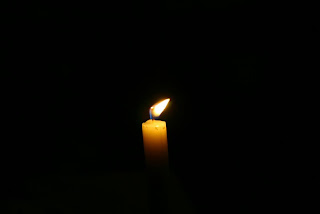Link to a choir rendition of Siyahamba, a South African song that relates to Ephesians 5“The LORD does not look at the things man looks at. Man looks at the outward appearance, but the LORD looks at the heart.” –1 Samuel 16:7
“Even though I walk through the valley of the shadow of death, I will fear no evil, for you are with me” –Psalm 23.4
“While I am in the world, I am the light of the world.” –John 9:5
“For you were once darkness, but now you are light in the Lord. Live as children of light … everything exposed by the light becomes visible, for it is light that makes everything visible.” –Ephesians 5:8-14
The theme of light and darkness is repeated throughout the Bible, particularly in the New Testament. In today’s lectionary, this theme – along with Samuel’s theme of true seeing – binds the passages together. In the selections I have pulled out, you can see a progression of sorts. In the Hebrew Scriptures, Samuel proclaims God’s ability to see past outward appearances into the heart – immune to deception or ill intent. In the most famous Psalm of David, David uses the image of a shadow for death, an image that has endured for about 3,000 years. In the Gospel of John, which makes eloquent use of this theme, Jesus declares himself “the light of the world.” Ephesians takes the theme even farther, encouraging Christians to “live as children of light” and ties this spiritual light with true seeing.
Although the contrast of light/darkness lends itself to dualism, it is interesting to note that darkness is not an equally powerful opposite of light, but merely its absence. Darkness is also completely incapable of overcoming light – even the faintest, palest light can vanquish some darkness. Also, anyone familiar with dimming house lights know that there are gradations of illumination – a gray area between pitch black and blinding light.
The above passage from John is found in the account of Christ healing a blind man on Sabbath. Pharisees interrogate the blind man, his parents and even Christ, unable to make sense of someone they see as a sinner (Because Jesus did not keep the Sabbath) able to perform such a prophetic act of healing. As the ordeal winds down, Jesus informs the blind man and the Pharisees, “For judgment I have come into this world, so that the blind will see and those who see will become blind” (John 9:39). Jesus connects his previous claim (“I am the light of the world”) with his current action – “I have come so that the blind may see.” Although Jesus has literally given sight to a man who was blind from birth, he is clearly speaking in metaphor. As darkness is absence of light, spiritual blindness is ignorance of the Lord.
What I find so interesting about this passage is that Jesus also says he will make those who see blind. When he states, “but now that you claim you can see, your guilt remains,” he is refuting the legitimacy of their claims to sight. Perhaps, like in 1 Samuel, they are only seeing outward appearance, unable to see into the heart. Those arrogant enough to assume they truly see the world for what it is are unable to achieve true spiritual sight. Christ seems to be adopting the Socratic ideal – perhaps an instance of the Greek influence on Jewish thought – that in order to become wise, you must first admit your ignorance. In a mysterious paradox, you must negate yourself as a knower in order to know anything.
Those who confess their blindness are absolved of their sin: “If you were blind, you would not be guilty of sin.” If we cling stubbornly to our “sight” our guilt will remain with us. We will remain in darkness, unable to attain knowledge of our true surroundings, and unable to abide by the advice in Ephesians to live as children of light, truly seeing God’s creation.


No comments:
Post a Comment